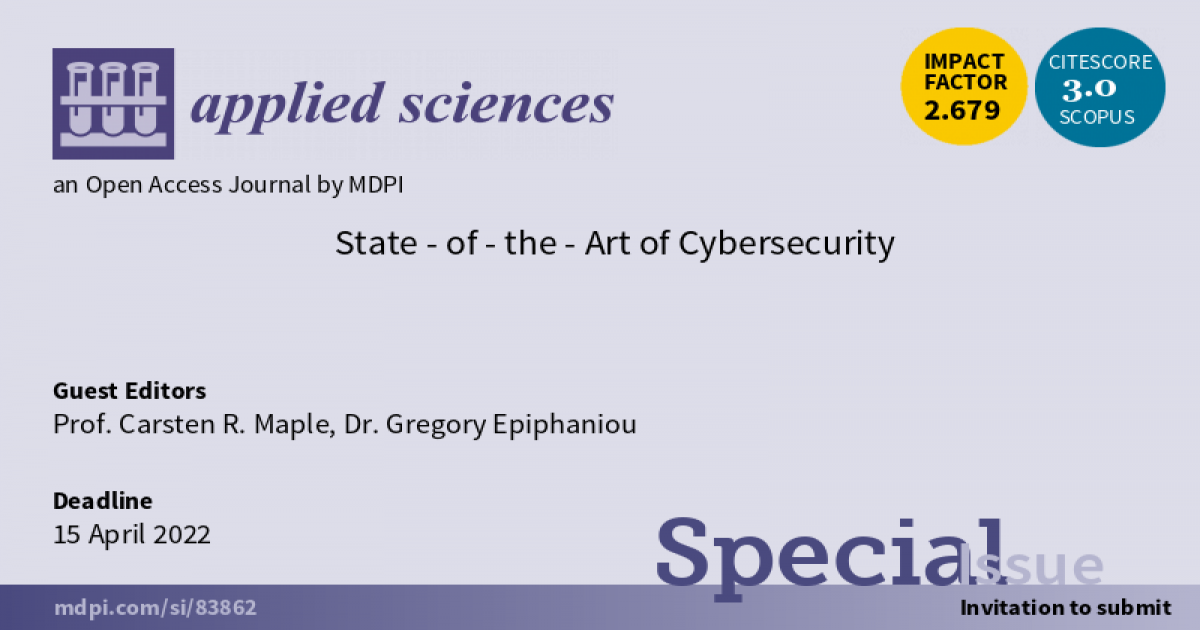State-of-the-Art of Cybersecurity
A special issue of Applied Sciences (ISSN 2076-3417). This special issue belongs to the section "Electrical, Electronics and Communications Engineering".
Deadline for manuscript submissions: closed (15 April 2022) | Viewed by 44683

Special Issue Editors
Interests: cyber-physical systems; cyber resilience
Special Issues, Collections and Topics in MDPI journals
Interests: cyber resilience; proactive network defence; physical layer security
Special Issues, Collections and Topics in MDPI journals
Special Issue Information
Dear Colleagues,
With the vast proliferation of cyber threats, the operation theatre is gradually changing, creating significant gaps in cyber decision-making capabilities when it comes to defence. Existing legal and regulatory compliance controls were not designed to operate in cyberspace, further dictating the necessity for the cyber resilience of critical mission systems. Cyber–physical systems emerge as a new operation theatre in warfare, with attacks against them no longer confined to the realm of cyberspace. This trend is also underpinned by our limited capacity to accurately quantify the imminent security risks of these mission-critical systems, taking into consideration the rapid change and variability in threat landscapes and associated vulnerabilities in our modern cyberspace. Additionally, most of our legacy cyber–physical systems are only secured in isolation to information systems’ architectures, in which they must gradually integrate. Both the transition and sustainability of these structures require a wider systems design approach as a reference for the interaction of these systems with networks and for holistic security from the component-level to the systems-level integration for cyberspace-enabled applications.
This Special Issue focuses on emerging topics in cybersecurity that support a wide range of applications with emphasis placed on the research directions of a) cyber resilience, b) risk and attack surface exposure analysis, c) security management processes and legal and regulatory ramifications in modern cyberinfrastructures and d) AI-enabled cyber threats and proactive defences.
This Special Issue is dedicated to publishing cutting-edge research addressing the various research trends and challenges in cybersecurity and provide insights to researchers and practitioners in the field.
Topics of interest include but not limited to the following:
- Cyber resilience and system security assessments;
- Cyber security risk in multidisciplinary contexts;
- Cyberthreat and effects’ modelling;
- Taxonomy and models for cyber defence;
- AI-Enhanced cyberthreats and defences;
- Cybersecurity legal and regulatory aspects;
- Cyber modelling and simulation for cyber incident analysis;
- Secure space communications;
- Privacy and data control;
- Secure quantum communications;
- Adversarial machine learning;
- IoT/CPS cybersecurity;
- Distributed technologies for defensive cyber operations;
- Physical layer security approaches;
- Threat network degradation;
- Cyber law and ethics;
- Cyberthreat information presentation;
- Intelligence-driven security operations;
- Compliance-aware security engineering;
- Cyber threat intelligence- and information-acquisition systems
Prof. Carsten R. Maple
Dr. Gregory Epiphaniou
Guest Editors
Manuscript Submission Information
Manuscripts should be submitted online at www.mdpi.com by registering and logging in to this website. Once you are registered, click here to go to the submission form. Manuscripts can be submitted until the deadline. All submissions that pass pre-check are peer-reviewed. Accepted papers will be published continuously in the journal (as soon as accepted) and will be listed together on the special issue website. Research articles, review articles as well as short communications are invited. For planned papers, a title and short abstract (about 100 words) can be sent to the Editorial Office for announcement on this website.
Submitted manuscripts should not have been published previously, nor be under consideration for publication elsewhere (except conference proceedings papers). All manuscripts are thoroughly refereed through a single-blind peer-review process. A guide for authors and other relevant information for submission of manuscripts is available on the Instructions for Authors page. Applied Sciences is an international peer-reviewed open access semimonthly journal published by MDPI.
Please visit the Instructions for Authors page before submitting a manuscript. The Article Processing Charge (APC) for publication in this open access journal is 2400 CHF (Swiss Francs). Submitted papers should be well formatted and use good English. Authors may use MDPI's English editing service prior to publication or during author revisions.
Benefits of Publishing in a Special Issue
- Ease of navigation: Grouping papers by topic helps scholars navigate broad scope journals more efficiently.
- Greater discoverability: Special Issues support the reach and impact of scientific research. Articles in Special Issues are more discoverable and cited more frequently.
- Expansion of research network: Special Issues facilitate connections among authors, fostering scientific collaborations.
- External promotion: Articles in Special Issues are often promoted through the journal's social media, increasing their visibility.
- e-Book format: Special Issues with more than 10 articles can be published as dedicated e-books, ensuring wide and rapid dissemination.
Further information on MDPI's Special Issue polices can be found here.






